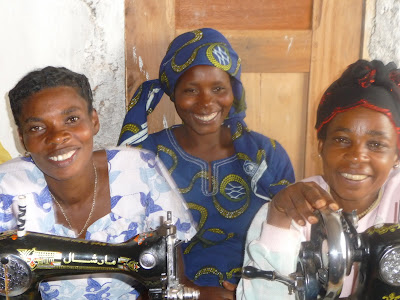
Located in south Bukavu, Panzi Hospital provides treatment for survivors of sexual violence and surgical repair for women suffering from fistulas in the urogential tract.

The hospital was founded in 1997 by Dr. Denis Mukwege, a gynecologist who wanted to reduce infant and maternal mortality in the rural population. It now serves as a referral source for other health centers who seek expertise in repairing obstetric fistulas and the damage done to women survivors of sexual, gender-based violence (SGBV).

The hospital is quite pleasant. One-storey, brick buildings are lined with tropical plants and roses. Patients sits on low walls waiting their turn to see the doctor.
Although Panzi is a general hospital, it boasts a relatively new women’s compound, which has two wards, one each for pre-op and post-op patients, and two large surgeries dedicated to fistula repair. During my visit, three American surgeons sponsored by Harvard Medical School were in attendence at Panzi, sharing their expertise and learning more from the patient population.

Administration and doctors' offices occupy the front buildings, while the women's wings spread out toward the back, opening to a lovely grass area with a pond, eucalyptus forest, and palapas where the women gather during the day.

There is a luxuriant garden on the grounds. To the side of that lies an area where young children, too large to be carried and not old enough to attend school, spend the day playing. Beyond that is the new nursing school building, soon to be completed.

This is my second visit to Panzi. I came a year ago and toured the hospital, but everyone was inside that day and the women's area had not been completed. Now there are people everywhere, doctors and nurses in lab coats, country women wrapped in colorful cloth, small children clinging to their mothers, crippled men on crutches, and a few muzungus (white people) touring the hospital.
There are over 300 rape survivors and fistula repair patients being treated at Panzi on a daily basis.

During the day, aides provide life skills training and teach handicrafts. All the women survivors are concerned about their future: How will they survive when they leave the hospital? Where will they live? Will they be able to support their children? Many practice handicrafts, learning to knit, sew, weave baskets and rush mats, in the hopes that this will sustain them.
 Up until now, my work with rape survivors has been with women several years out of hospital, who had been raped, treated and then released. Being at Panzi Hospital surrounded by so many raped and damaged women, most in pain, all ashamed and trying to make sense out of their shattered lives, is an astonishing, humbling experience.
Up until now, my work with rape survivors has been with women several years out of hospital, who had been raped, treated and then released. Being at Panzi Hospital surrounded by so many raped and damaged women, most in pain, all ashamed and trying to make sense out of their shattered lives, is an astonishing, humbling experience.
 I feel the full weight of the evil done to these innocent women. So much damage has been done for what? What could ever justify this cruelty, this suffering?
I feel the full weight of the evil done to these innocent women. So much damage has been done for what? What could ever justify this cruelty, this suffering?
With love and gratitude,
 Psychosocial staff: (l. to r.) Joseph, Sarah, Roger (my translator), Ester, Lidia, Helen, Yvette, Cecile, Pascaline, Rosa (front)
Psychosocial staff: (l. to r.) Joseph, Sarah, Roger (my translator), Ester, Lidia, Helen, Yvette, Cecile, Pascaline, Rosa (front) Women survivors wait to see caregivers.
Women survivors wait to see caregivers. 





















 The hospital was founded in 1997 by Dr. Denis Mukwege, a gynecologist who wanted to reduce infant and maternal mortality in the rural population. It now serves as a referral source for other health centers who seek expertise in repairing obstetric fistulas and the damage done to women survivors of sexual, gender-based violence (SGBV).
The hospital was founded in 1997 by Dr. Denis Mukwege, a gynecologist who wanted to reduce infant and maternal mortality in the rural population. It now serves as a referral source for other health centers who seek expertise in repairing obstetric fistulas and the damage done to women survivors of sexual, gender-based violence (SGBV).


 There is a luxuriant garden on the grounds. To the side of that lies an area where young children, too large to be carried and not old enough to attend school, spend the day playing. Beyond that is the new nursing school building, soon to be completed.
There is a luxuriant garden on the grounds. To the side of that lies an area where young children, too large to be carried and not old enough to attend school, spend the day playing. Beyond that is the new nursing school building, soon to be completed. 

 Up until now, my work with rape survivors has been with women several years out of hospital, who had been raped, treated and then released. Being at Panzi Hospital surrounded by so many raped and damaged women, most in pain, all ashamed and trying to make sense out of their shattered lives, is an astonishing, humbling experience.
Up until now, my work with rape survivors has been with women several years out of hospital, who had been raped, treated and then released. Being at Panzi Hospital surrounded by so many raped and damaged women, most in pain, all ashamed and trying to make sense out of their shattered lives, is an astonishing, humbling experience. I feel the full weight of the evil done to these innocent women. So much damage has been done for what? What could ever justify this cruelty, this suffering?
I feel the full weight of the evil done to these innocent women. So much damage has been done for what? What could ever justify this cruelty, this suffering?